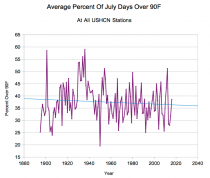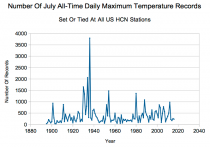New Report Definitively Shows UN CAGW Hypothesis and IPCC Reports Invalid and Thus CPP and Paris Treaty Total Wastes
Alan Carlin
As discussed in my book, Environmentalism Gone Mad, two of the reasonable inferences from the Catastrophic Anthropogenic Global Warming (CAGW) hypothesis (the scientific basis for the world climate scare pushed by the United Nations and the Obama Administration) are that atmospheric carbon dioxide (CO2) levels should affect global temperatures, and that the resulting heat generated should be observable by a hot spot about 10 km over the tropics. In fact, the United Nations Intergovernmental Panel on Climate Change (UNIPCC) argues that both should exist and the US Environmental Protection Agency (USEPA) uses the hot spot as one of its three “lines of evidence” for justifying its Greenhouse Gas (GHG) Endangerment Finding (EF).
The EF, in turn, is used by EPA to justify all its climate regulations, including its ultra-expensive so-called “Clean Power Plan” (CPP} requiring that many coal plants be replaced with wind and solar-generated electric power at huge expense to ratepayers in terms of outlays and reductions in reliability as well as to taxpayers for government subsidies. The 2016 Democratic Party Platform last July now carries this approach to a new extreme by advocating that all use of fossil fuels be ended by 2050, which is highly unlikely to even be achievable at any cost.
Climate skeptic scientists have long questioned whether the effects of relatively minor (compared to other CO2 sources and sinks) human-caused emissions of CO2 have more than a minor effect on global temperatures and some have even questioned whether the UN and USEPA have even gotten the causation backwards (i.e., because on balance global temperatures affect atmospheric CO2 levels). A very interesting new study shows that their skepticism has been more than justified. By using sophisticated econometric/statistical methods on 13 different climate databases for the years 1959 to 2015 where available, the study concludes that the changes in CO2 have no measurable net effects on global temperatures but that global temperatures affect CO2 levels. The real advance in the new study is that it assumes that global temperatures may affect atmospheric CO2 levels in addition to assuming that CO2 may affect global temperatures (as assumed by UNIPCC and USEPA). This introduces complexity to the analysis but is a crucial improvement over most earlier studies.
New Research Findings Support Earlier Research by Skeptics
This conclusion is exactly what Dr. Murry Salby has independently concluded in recent years. Unfortunately, his conclusions resulted in the loss of his professorship at Macquarie University in Australia in 2013 and the confiscation of his research notes by climate alarmists at the University. As a result, his research has not been published to date in journal format as far as I know. The absence of any measurable effect of CO2 on global temperatures and the resulting missing hot spot invalidates the CAGW hypothesis in terms of the Scientific Method, and thus the EPA EF as well as the basis for the UN IPCC physical science reports and thus the scientific basis for the Paris Treaty of 2015 as well as the USEPA CPP. Alarmist scientists have tried to argue that the hot spot is actually present, but have failed to make a convincing case.
The new research report is consistent with the findings of Environmentalism Gone Mad that CAGW is invalid because reasonable inferences from it are not supported by comparisons with real world data (as required by the scientific method), but goes beyond it by providing still another, and a more sophisticated, basis for rejecting the UNIPCC/USEPA CAGW hypothesis.
The new econometric/statistical report shows that that the minor increases in global temperatures can be entirely explained by natural factors. By subtracting temperature changes due to the El Nino Southern Oscillation (ENSO) the report shows that there is no role for human emissions of CO2 as a cause of global warming.
The Role of ENSO in Determining Global Temperatures
It has long been evident even to a casual observer that global temperatures vary with ENSO since these temperatures consistently increase when El Nino conditions prevail and fall when La Nina conditions prevail. The alarmists have generally tried to ignore this reality, but in the last year or two even they have finally begun to recognize the role of ENSO in global temperatures and eagerly awaited the expected increase in global temperatures (the so-called highest recorded temperatures resulting from the 2016 El Nino) in order try to justify their now invalidated CAGW hypothesis.
Atmospheric CO2 levels, on the other hand, have been increasing fairly steadily and bear no obvious similarity to global temperatures. Previous skeptic studies have simply looked for the hot spot and not found it. But the new study shows that the current warming can be fully explained by including ENSO variations in the analysis and that while changes in CO2 levels must be considered in the analysis, it turned out that they can safely be ignored, which is even more than most skeptics have long argued.
The authors believe that ENSO is a natural phenomenon and I agree. There is no basis I know of for arguing that the gradual and fairly steady increases in atmospheric CO2 levels would bring about the ENSO fluctuations in the vast Central Pacific Ocean. ENSO has been observed over long periods and predated humans. The authors believe that ENSO appears to be influenced by changes in solar activity, so such oscillations are highly unlikely to be human influenced. Thus there is no basis to blame human activities for global temperature changes as the alarmists claim. And there is thus no basis for claiming that humans must reduce their CO2 emissions in order to avoid CAGW at the cost of hundreds of trillions of dollars, much less reliable energy supplies, and significantly lower economic growth by using wind and solar energy.
In the words of the new report:
These analysis results would appear to leave very, very little doubt that EPA’s claim of a Tropical Hot Spot [THS], caused by rising atmospheric CO2 levels, simply does not exist in the real world. Also critically important, even on an all-other-things-equal basis, this analysis failed to find that the steadily rising atmospheric CO2 concentrations have had a statistically significant impact on any of the 13 temperature time series analyzed.
Thus, the analysis results invalidate each of the Three Lines of Evidence in its CO2 Endangerment Finding. Once EPA’s THS assumption is invalidated, it is obvious why the climate models they claim can be relied upon, are also invalid. And, these results clearly demonstrate - 13 times in fact - that once just the ENSO impacts on temperature data are accounted for, there is no “record setting” warming to be concerned about. In fact, there is no ENSO-Adjusted Warming at all. These natural ENSO impacts involve both changes in solar activity and the 1977 Pacific Shift.
Moreover, on an all-other-things-equal basis, there is no statistically valid proof that past increases in Atmospheric CO2 Concentrations have caused the officially reported rising, even claimed record setting temperatures. To validate their claim will require mathematically credible, publicly available, simultaneous equation parameter estimation work. Where is it?
So it is time to pursue other ways to improve the environment and not waste further time and resources on the scientifically invalid CAGW hypothesis. It is a failed hypothesis, nothing more. (Although it is true that conventional pollutants may be reduced by decreasing coal use, there are much cheaper ways to control such pollutants than reducing coal use if and when there should be a need for further such controls.) Accordingly, there is now definitive evidence that the Paris Treaty and actions taken in response to it will serve no useful purpose and should be abandoned.
Massive Cover-up Exposed: 285 Papers From 1960s-’80s Reveal Robust Global Cooling Scientific ‘Consensus’
By Kenneth Richards on NoTricksZone
Beginning in 2003, software engineer William Connolley quietly removed the highly inconvenient references to the global cooling scare of the 1970s from Wikipedia, the world’s most influential and accessed informational source.
It had to be done. Too many skeptics were (correctly) pointing out that the scientific “consensus” during the 1960s and 1970s was that the Earth had been cooling for decades, and that nascent theorizing regarding the potential for a CO2-induced global warming were still questionable and uncertain.
Not only did Connolley - a co-founder (along with Michael Mann and Gavin Schmidt) of the realclimate.com blog - successfully remove (or rewrite) the history of the 1970s global cooling scare from the Wikipedia record, he also erased (or rewrote) references to the Medieval Warm Period and Little Ice Age so as to help create the impression that the paleoclimate is shaped like Mann’s hockey stick graph, with unprecedented and dangerous 20th/21st century warmth.
A 2009 investigative report from UK’s Telegraph detailed the extent of dictatorial-like powers Connolley possessed at Wikipedia, allowing him to remove inconvenient scientific information that didn’t conform to his point of view.
“All told, Connolley created or rewrote 5,428 unique Wikipedia articles. His control over Wikipedia was greater still, however, through the role he obtained at Wikipedia as a website administrator, which allowed him to act with virtual impunity. When Connolley didn’t like the subject of a certain article, he removed it - more than 500 articles of various descriptions disappeared at his hand. When he disapproved of the arguments that others were making, he often had them barred - over 2,000 Wikipedia contributors who ran afoul of him found themselves blocked from making further contributions. Acolytes whose writing conformed to Connolley’s global warming views, in contrast, were rewarded with Wikipedia’s blessings. In these ways, Connolley turned Wikipedia into the missionary wing of the global warming movement.”
After eviscerating references to 1970s global cooling scare and the warmer-than-now Medieval Warm Period from Wikipedia, and after personally rewriting the Wikipedia commentaries on the greenhouse effect to impute a central, dominant role for CO2, Connolley went on to team up with two other authors to publish a “consensus” manifesto in 2008 that claimed to expose the 1970s global cooling scare as a myth, as something that never really happened.
Peterson, Connolley, and Fleck (2008, hereafter PCF08) published “The Myth of the 1970s Global Cooling Scientific Consensus” in Bulletin of the American Meteorological Society, hoping to quash once and for all the perception that there were scientists in the 1960s and 1970s who agreed the Earth was cooling (and may continue to do so), or that CO2 did not play a dominant role in climate change.
The Concoction Of ‘Consensus’ Achieved Via Exclusion
The primary theme of PCF08 can be summarized in 4 succinctly quoted sentences from the paper:
“[T]he following pervasive myth arose [among skeptics]: there was a consensus among climate scientists of the 1970s that either global cooling or a full-fledged ice age was imminent. A review of the climate science literature from 1965 to 1979 shows this myth to be false… During the period from 1965 through 1979, our literature survey found 7 cooling, 20 neutral, and 44 warming papers...There was no scientific consensus in the 1970s that the Earth was headed into an imminent ice age. Indeed, the possibility of anthropogenic warming dominated the peer-reviewed literature even then.”
William Connolley and colleagues claimed that the determination of scientific “consensus” regarding global cooling and the influence of CO2 on climate during the 1970s could be divined by counting scientific publications that fell into arbitrarily-defined categories which allowed them to intentionally exclude hundreds of papers that would undermine the alleged myth-slaying purpose of the paper.
The PCF08 authors decided that when “quantifying the consensus” (by counting publications), a scientific paper could only be classified as a “cooling” paper if it projected that future temperatures would (continue to) decline, or that a “full-fledged ice age was imminent.” Papers published during the arbitrarily chosen 1965-’79 era that affirmed the climate had already been cooling for decades, that this cooling wasn’t a positive development, and/or that the effects of CO2 on climate were questionable or superseded by other more influential climate change mechanisms… were not considered worthy of classification as a “cooling” paper, or as a paper that disagreed with the claimed “consensus” that said the current (1960s-1970s) global cooling will someday be replaced by CO2-induced global warming.
Of course, the global cooling scare during the 1970s was not narrowly or exclusively focused upon what the temperatures might look like in the future, or whether or not an ice age was “imminent”. It was primarily about the ongoing cooling that had been taking place for decades, the negative impacts this cooling had already exerted (on extreme weather patterns, on food production, etc.), and uncertainties associated with the causes of climatic changes.
By tendentiously excluding 1960s and 1970s publications that documented global cooling had been ongoing and a concern, as well as purposely excluding papers that suggested the climate’s sensitivity to CO2 forcing is weak or questionable relative to other mechanisms, the authors could brazenly claim that there were only 7 papers published in the scientific literature between 1965 and 1979 that disagreed with the “consensus” opinion that global warming would occur at some point in the future (due to CO2 increases). According to PCF08, there were 44 papers that fell into the latter warming-is-imminent-due-to-CO2 category from 1965-’79, ostensibly entitling them to claim that dangerous anthropogenic global warming projections “dominated” the scientific literature even then.
An 83% Global Cooling/Weak CO2 Influence Scientific ‘Consensus’ During 1960s, ‘70s
As will be shown here, the claim that there were only 7 publications from that era disagreeing with the presupposed CO2-warming “consensus” is preposterous. Because when including the papers from the 1960s and 1970s that indicated the globe had cooled (by -0.3C between the 1940s and ‘70s), that this cooling was concerning (leading to extreme weather, drought, depressed crop yields, etc.), and/or that CO2’s climate influence was questionable to negligible, a conservative estimate for the number of scientific publications that did not agree with the alleged CO2-warming “consensus” was 220 papers for the 1965-’79 period, not 7. If including papers published between 1960 and 1989, the “non-consensus” or “cooling” papers reaches 285.
Again, these estimates should be viewed as conservative. There are likely many dozen more scientific papers from the 1960s-’70s cooling scare era that would probably fall into the category of a “cooling” paper, but have not yet been made available to view in full online.
But let us say that the PCF08 claim is true, and that there were indeed only 44 papers published between 1965-’79 that endorsed the position that the Earth’s climate is predominately shaped by CO2 concentrations, and thus the Earth would someday start warming as the models had suggested. Interestingly, if we were to employ the hopelessly flawed methodology of divining the relative degree of scientific “consensus” by counting the number of papers that agree with one position or another (just as blogger John Cook and colleagues did with their 2013 paper “Quantifying the Consensus..” that yielded a predetermined result of 97% via categorical manipulation), the 220 “cooling” papers published between 1965-’79 could represent an 83.3% global cooling consensus for the era (220/264 papers), versus only a 16.7% consensus for anthropogenic global warming (44/264 papers).
The 1970s Global Cooling Scare Was Not Mythological
In reviewing the available scientific literature from the 1960s-’80s, it is plainly evident that there was a great deal of concern about the ongoing global cooling, which had amounted to -0.5C in the Northern Hemisphere and -0.3C globally between the 1940s and 1970s.
Of course, this inconvenient global-scale cooling of -0.3C between the 1940s and 1970s has necessarily been almost completely removed from the instrumental record by NASA (GISS) and the MetOffice (HadCRUT). After all, the observations (of cooling) conflicted with climate modeling. Overseers of the surface temperature datasets (such as the MetOffice’s Phil Jones or NASA’s Gavin Schmidt) have recently adjusted the -0.3C of cooling down to just hundredths of a degree of cooling. NASA GISS, for example, has reduced (via “adjustments") the global cooling down to about -0.01C between the 1940s and 1970s, as shown below. It is likely that, during the next few years of adjustments to past data, the mid-20th century global cooling period will disappear altogether and mutate into a warming period.
For those who actually experienced the non-mythological cooling scare during the 1960s and 1970s (that has since been made to disappear from graphs), the consequences of the -0.5 Northern Hemispheric cooling (especially) were frequently discussed in scientific publications. There were geoengineering strategies proposed by scientists to melt Arctic sea ice. Droughts and floods and extreme weather anomalies/variability were blamed on the ongoing global cooling. Glaciers were advancing, even surging at accelerated rates during this period. Sea ice growth and severe Arctic cooling meant that the oceans were much less navigable. Crop growth and food production slowed as the Earth cooled, which was of great concern to world governments. Severe winters in the 1960s and 1970s led many climatologists to assume that the Earth was returning to an 1800s-like Little Ice Age climate. Observations of mammals migrating to warmer climates during the 1960s and 1970s due to the colder temperatures were reported in scientific papers.
For those who actually experienced the non-mythological cooling scare during the 1960s and 1970s (that has since been made to disappear from graphs), the consequences of the -0.5 Northern Hemispheric cooling (especially) were frequently discussed in scientific publications. There were geoengineering strategies proposed by scientists to melt Arctic sea ice. Droughts and floods and extreme weather anomalies/variability were blamed on the ongoing global cooling. Glaciers were advancing, even surging at accelerated rates during this period. Sea ice growth and severe Arctic cooling meant that the oceans were much less navigable. Crop growth and food production slowed as the Earth cooled, which was of great concern to world governments. Severe winters in the 1960s and 1970s led many climatologists to assume that the Earth was returning to an 1800s-like Little Ice Age climate. Observations of mammals migrating to warmer climates during the 1960s and 1970s due to the colder temperatures were reported in scientific papers.
Synonyms for the 1960s-’70s climate cooling conditions commonly used in the literature were words such as deterioration, recession, detrimental, and severe. In contrast, warming periods such as during the warmer Medieval times or the warm-up during the first half of the 20th century were referred to positively, or as optimum (i.e., the Medieval Warm Period was referred to as the “Little Optimum").
According to Stewart and Glantz (1985), in the early 1970s it was the “prevailing view” among scientists that the Earth was headed into another ice age. It wasn’t until the late ‘70s that scientists changed their minds and the “prevailing view” began shifting to warming. This is in direct contradiction to the claims of PCF08, who allege warming was the prevailing view among scientists in the 1960s and early 1970s too. Furthermore, as recently as 1985, it was still acknowledged that “the causes of global climate change remain in dispute.”
Stewart and Glantz, 1985
“The conclusions of the NDU study might have been predicted from a knowledge of the prevailing ‘spirit of the times’ (i.e., the prevailing mood in the science community) when the first part was conducted. This was an interesting time in recent history of climate studies. One could effectively argue that in the early 1970s the prevailing view was that the earth was moving toward a new ice age. Many articles appeared in the scientific literature as well as in the popular press speculating about the impact on agriculture of a 1-2C cooling. By the late 1970s that prevailing view had seemingly shifted 180 degrees to the belief that the earth’s atmosphere was being warmed as a result of an increasing CO2 loading of the atmosphere. ... The causes of global climate change remain in dispute. Existing theories of climate, atmospheric models, and actuarial experience are inadequate to meet the needs of policymakers for information about future climate.”
According to scientists reporting to the U.S. Central Intelligence Agency (1974), 22 of 27 forecasting methods predicted a cooling trend for the next 25 years, and “meteorological experts” were thinking an 1800s climate was around the corner, with the concomitant return to monsoon failures, shorter growing seasons, and “violent weather”.
U.S. Central Intelligence Agency,1974
Potential Implications of Trends in World Population, Food Production, and Climate
“According to Dr. Hubert Lamb–an outstanding British climatologist, 22 out of 27 forecasting methods he examined predicted a cooling trend through the remainder of this century. A change of 2-3 F. in average temperature would have an enormous impact… A number of meteorological experts are thinking in terms of a return to a climate like that of the 19th century. This would mean that within a relatively few years (probably less than two decades, assuming the cooling trend began in the 1960’s) there would be brought belts of excess and deficit rainfall in the middle-latitudes; more frequent failure of the monsoons that dominate the Indian sub-continent, south China and western Africa; shorter growing seasons for Canada, northern Russia and north China. Europe could expect to be cooler and wetter… [I]n periods when climate change [cooling] is underway, violent weather - unseasonal frosts, warm spells, large storms, floods, etc. is thought to be more common.”
------------
See in Real Science how NOAA adjustments increased July warming by 1000% here.
NOAA’s NCED (National Center for Environmental Disinformation) creates this warming by massively cooling the past. They got rid of the hot 1901 by cooling it 2.13 degrees. The cooled 1936 by by 1.13 degrees and cooled 1934 by 1.11 degrees. That is what it took to elevate 2012 to the hottest July.
NOAA shows July temperatures increasing at 1.0F per century since 1895, with 2012 tied with 1936 as the hottest July.
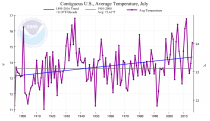
Enlarged
Climate at a Glance | National Centers for Environmental Information (NCEI)
The actual raw temperature data they use to generate their graph, shows one tenth as much warming from 1895 to 2016, with 1901, 1936 and 1934 as the hottest years.
If 1895 is removed, there is no warming at all.
NOAA creates this warming by massively cooling the past. They got rid of the hot 1901 by cooling it 2.13 degrees. The cooled 1936 by by 1.13 degrees and cooled 1934 by 1.11 degrees. That is what it took to elevate 2012 to the hottest July.
A good measure of how fraudulent the NOAA adjustments are, is the percent of days over 90 degrees. July 1936, 1901, 1934, 1931, 1930 and 1954 all had more days over 90 degrees than 2012 did, yet NOAA shows 2012 as the hottest. The frequency of 90 degree days in the US has declined since the start of records in 1895. July 2016 (NASA’s hottest July ever) was almost exactly average since 1895.
Another very good measure of how fraudulent the NOAA graph is, is the number of July daily maximum temperature records. The 1930’s were much hotter than any recent years.
The claimed warming trend in the US is completely fake, and is altered by people at NOAA who are being paid to push the global warming agenda. Before they were paid to push anthropogenic warming, the very same people at NOAA (i.e. Tom Karl) knew that there was no US warming.
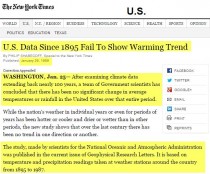
Enlarged
U.S. Data Since 1895 Fail To Show Warming Trend - NYTimes.com
The US makes up less than 10% of the land surface, but contains the majority of the high quality long term temperature monitoring stations for this planet. The global surface temperature record is a farce, which is why the US data is so important.



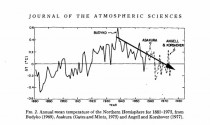
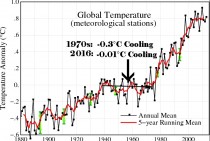
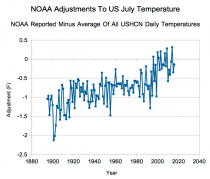
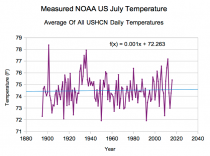
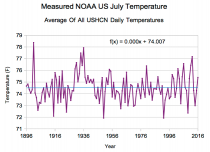
_thumb.png)
